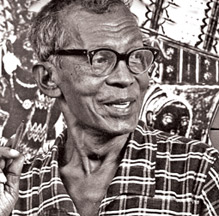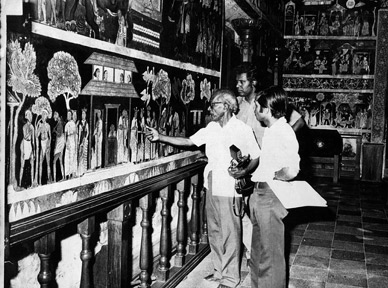|
L. T. P. Manjusri:
Painter scholar of rare calibre
By Tissa HEWAVITARANA
The temple paintings of the 18th, 19th and early 20th centuries are
some of Sri Lankan greatest national art treasures. They contribute a
rich and distinctive authentic Sri Lankan contribution to the art of
Asia. Many Buddhist temples and shrines with brightly painted interiors
still exist throughout the country. These paintings narrative and
decorative represent the phase of Sri Lankan tradition of mural
paintings that is over 200 years old. It is only in recent years that
the extraordinary artistic and historical value of these murals has
become widely recognised among the art lovers.
 L. T. P. Manjusri scholar, and lover of our national art and culture
was one of a handful of pioneering Sri Lankan artists who took an
interest in studying and publicising these late period paintings. Early
in the 1930s Manjusri has devoted himself to studying and copying these
murals. He has gathered a vast and invaluable unique collection of
material which consists of copies and tracings sketches and drawings.
Manjusri's illustrations and his valuable writings on these subjects
throughout the years are familiar to the Sri Lankan people. These copies
are today prize exhibits in numerous and other collections both here and
abroad. L. T. P. Manjusri scholar, and lover of our national art and culture
was one of a handful of pioneering Sri Lankan artists who took an
interest in studying and publicising these late period paintings. Early
in the 1930s Manjusri has devoted himself to studying and copying these
murals. He has gathered a vast and invaluable unique collection of
material which consists of copies and tracings sketches and drawings.
Manjusri's illustrations and his valuable writings on these subjects
throughout the years are familiar to the Sri Lankan people. These copies
are today prize exhibits in numerous and other collections both here and
abroad.
L. T. P. Manjusri was born in 1902 in the small town of Alutgama
midway between Colombo and Galle, South-West coast. His formal schooling
did not take him far. He set out to discover the world for himself when
he was only 11 years old. This man dreamed a greater number of dreams in
a vast variety of fields and turned them into reality. First he became
an apprentice to a carpenter then as a companion to one of his uncles
who was a ballad singer, and finally as an assistant in a small shop
owned by a cousin in Beruwala.
It was while working in this shop that he saw with fascination,
bhikkhus and samaneras - Buddhist monks draped in Saffron (Yellow) robes
walking in procession or going about their daily mendicant round. He was
deeply moved by Buddhist traditions as his grandfather Kovis Gurunanse
had been a Buddhist monk in his youth.
Manjusri himself was ordained as a Samanera at the age of 13. He
began his studies at the Mangala Pirivena at Beruwala as a pupil of two
famous scholars living at that time Ven. Telvatta Ariyawansa and Ven.
Talwatta Amarawansa. Before he was 20 he had already become a reputed
scholar. He studied Pali, Sanskrit and Bengali instead and went to
Shantiniketan and learnt Chinese translation of Buddhist texts. At.
Shantiniketan he met Nandalal Bose who introduced him to painting. After
studying in India for a short period, on his return to Sri Lanka in 1934
Manjusri started to make copies of Buddhist temple murals.
Later these were taken back with him to Shantiniketan where they were
exhibited together with some of Ravindranath Tagore's own work. Manjusri
later travelled to the slopes of Himalayas to study Tibetan iconography
where he met Uchima the artist of the Tashima Lama.
Manjusri returned to Sri Lanka in 1937 and started making copies of
temple murals while producing his own original work as well. He favoured
the use of water-colours which he used meticulously. His association and
his friendship with Harry Pieris led him to become one of the founder
members of the '43 Group.
 |
|
Manjusri inspects
Temple paintings |
At the end of 1947 Manjusri went to England and in 1948 held an
exhibition in London of mural copies and original paintings. The same
year he visited Austria where he exhibited in Vienna. He returned to Sri
Lanka in 1949 and gave up robes and became a laymen to become henceforth
L.T. Pieris, but he retained the monastic name Manjusri and from there
onwards known as L.T.P. Manjusri.
He served as a journalist in several leading newspapers of the day.
He first worked at Lankadeepa newspaper and later joined the Lake House
group of newspapers and worked in the Janatha, Silumina and Daily News
Paper as a leading feature writer. In 1981 he was awarded an honourary
doctorate by the Peradeniya University and Ramon Magsay say prize in
1979. He married in 1955 and has a son and a daughter who have followed
in their father's footsteps. Manjusri's work as a painter was
outstanding. His pictures were great because they came out of the
goodness of his heart. He studied and copied and absorbed into his very
lifeblood the classical master pieces of the temple murals.
Majusri's work has been acquired by the New York Public Library, the
Horniman Museum, the Vienna Museum and by numerous other private
collectors, the most notable being that of Ann Mitchell in London.
He was commissioned by the Steuben Glass Factory New York to execute
a design of a classical figure of Maya the personification of illusion
in Hindu mythology which was engraved for a crystel vas to be exhibited
in 'Asian Artists in crystle' in 1956.
L.T.P. Manjusri was born on 28 October 1902 and died on 16 June 1982.
He was an artist and a scholar of international repute.
(www.tissahewavitarane.com)
|

